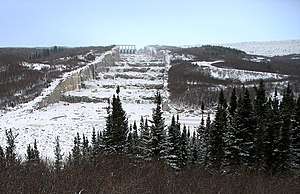Stepped spillway
A stepped spillway is a spillway with steps on the spillway chute to assist in the dissipation of the kinetic energy of the descending water. This eliminates or reduces the need for an additional energy dissipator, such as a body of water, at the end of the spillway downstream.

Historical developments
Stepped spillways, consisting of weirs and channels, have been used for over 3,500 years since the first structures were built in Greece and Crete. During Antiquity, the stepped chute design was used for dam spillways, storm waterways, and in the town water supply channels. Most of these early structures were built around the Mediterranean Sea, and the expertise on stepped spillway design was spread successively by the Romans, Muslims and Spaniards.[1]
Although the early stepped spillways were built in cut-stone masonry, unlined rock and timber, a wider range of construction materials was introduced during the mid-19th century, including the first concrete stepped spillway of the Gold Creek dam (1890) in Brisbane, Australia. During the first half of the 20th century, the stepped cascade design became out of fashion, partly because of the maintenance costs but also because of the development in hydraulic jump stilling basins. Yet the long-lasting operation of several famous stepped cascades has demonstrated the soundness of the stepped spillway design.
Although the stepped spillway design was common up to the beginning of the 20th century, a lot of expertise has been lost since, and the present expertise is limited to very simple geometries, namely some flat horizontal stepped prismatic chutes, despite some recent interest in stepped spillway design.[2][3]
Basic flow characteristics
The flow over a stepped spillway may be divided into three distinct flow regimes depending upon the flow rate for a given stepped spillway geometry: nappe, transition and skimming flow regimes with increasing flow rates.[3] For a given stepped spillway geometry, the nappe flows are observed for small discharges. They are characterized by a succession of free-falling nappes at each step edge, followed by nappe impact on the following step. The transition flows are observed for a range of intermediate discharges. Some strong hydrodynamic fluctuations, splashing and spray near the free surface constitute the main features of this flow regime. To date, the transition flow is avoided for design flow conditions because of past failures.
The skimming flow regime is observed for the largest discharges. The waters skim over the pseudo-bottom formed by the step edges as a coherent turbulent flow. Beneath the pseudo-bottom some intense recirculation and vertical structures fill the cavities.[4] These recirculation eddies are maintained by the transmission of shear stress from the mainstream and they contribute significantly to the energy dissipation down the stepped spillway.
For a small dam, the nappe flow is considered most efficient in terms of energy dissipation, while the skimming flow is most efficient for long spillway chutes and large dams.[2]
Discussion
Gabion stepped weirs are commonly used for embankment protection, river training and flood control; the stepped design enhances the rate of energy dissipation in the channel, and it is particularly well-suited to the construction of gabion stepped weirs.[5] For very low flow, a porous seepage flow regime may be observed, when the water seeps through the gabion materials and there is no overflow past the step edges.
See also
References
- Chanson, H. (2001–2002). Historical Development of Stepped Cascades for the Dissipation of Hydraulic Energy. Transactions of the Newcomen Society, Vol. 71, No. 2, pp. 295-318 (ISSN 0372-0187).
- Chanson, H. (1995). Hydraulic Design of Stepped Cascades, Channels, Weirs and Spillways. Pergamon, Oxford, UK, Jan., 292 pages. ISBN 0-08-041918-6.
- Chanson, H. (2001). The Hydraulics of Stepped Chutes and Spillways. Balkema, Lisse, The Netherlands. ISBN 90-5809-352-2.
- Rajaratnam, N. (1990). Skimming Flow in Stepped Spillways. Jl of Hyd. Engrg., ASCE, Vol. 116, No. 4, pp. 587-591.
- Wuthrich, D. and Chanson, H. (2014). "Hydraulics, Air Entrainment and Energy Dissipation on Gabion Stepped Weir". Journal of Hydraulic Engineering. 140 (9): Paper 04014046, 10 pages. doi:10.1061/(ASCE)HY.1943-7900.0000919. ISSN 0733-9429.CS1 maint: multiple names: authors list (link)
External links
- Stepped Spillway Research – (2017), The University of Queensland